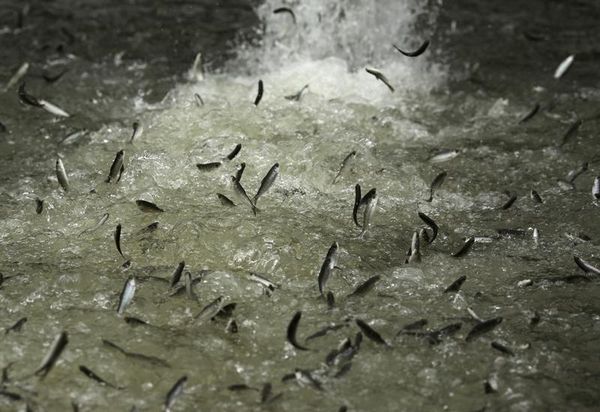Protected California salmon numbers drop as drought warms water
Date: 30-Oct-15
Country: USA
Author: Sharon Bernstein

Thousands of juvenile
salmon are sent into a holding tank in the Sacramento River in Rio
Vista, California in this March 25, 2014 file photo.
Photo: Robert Galbraith
The number of young winter run Chinook salmon in the Sacramento River is considerably lower so far this year than in 2014, federal authorities said, prompting concerns that the drought is making it harder for the endangered species to recover.
Federal wildlife experts said that so far this year, they had counted 22 percent fewer juvenile Winter Run Chinook salmon in the river than last year - itself a very shaky year for the fish, which are at risk of extinction and protected by the U.S. Endangered Species Act.
"Last year was a problem, and this year looks like it could be a problem," said Garwin Yip, Water Operations and Delta Consultations Branch Chief for the National Oceanic and Atmospheric Administration (NOAA) in Sacramento. "This is of concern."
Winter run Chinook swim out to the Pacific Ocean via the Sacramento-San Joaquin River Delta, heading out at last under the Golden Gate Bridge over the next few months, Yip said.
Wildlife managers are hoping that winter storms will make conditions more favorable, and that more young fish will begin that journey downstream of Shasta Dam in Northern California during November and December, Yip said.
But the state is in its fourth year of a devastating drought that has, among other things, caused the temperature in the river to become warmer. The predicted El Nino weather and oceanic temperature pattern that is expected to bring rain to California later this year will not necessarily lead to precipitation as far north as Shasta, meaning that the river could remain low and warm.
"Water temperature has a lot to do with the mortality of the fish," Yip said. The juvenile Chinook take their cues to start swimming downstream in part from the coldness of the water, he said.
Warm water makes them lethargic and vulnerable to predators and infections, Yip said.
As of last week, 217,489 juvenile Chinook had been counted so far this year downstream of Shasta Dam. That is 62,463 fewer than last year, according to NOAA data.
By the same week in 2014, 279,952 had been counted - itself a dramatic drop from the previous year, when 636,764 juveniles were spotted in the river by Oct. 21, according to NOAA data.
(Editing by Eric Walsh)
![]()
© Thomson Reuters 2015 All rights reserved